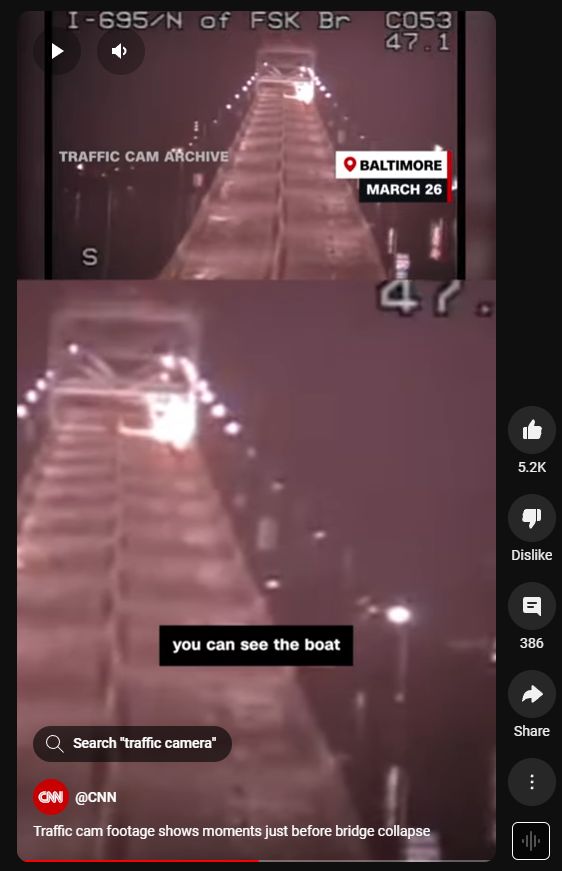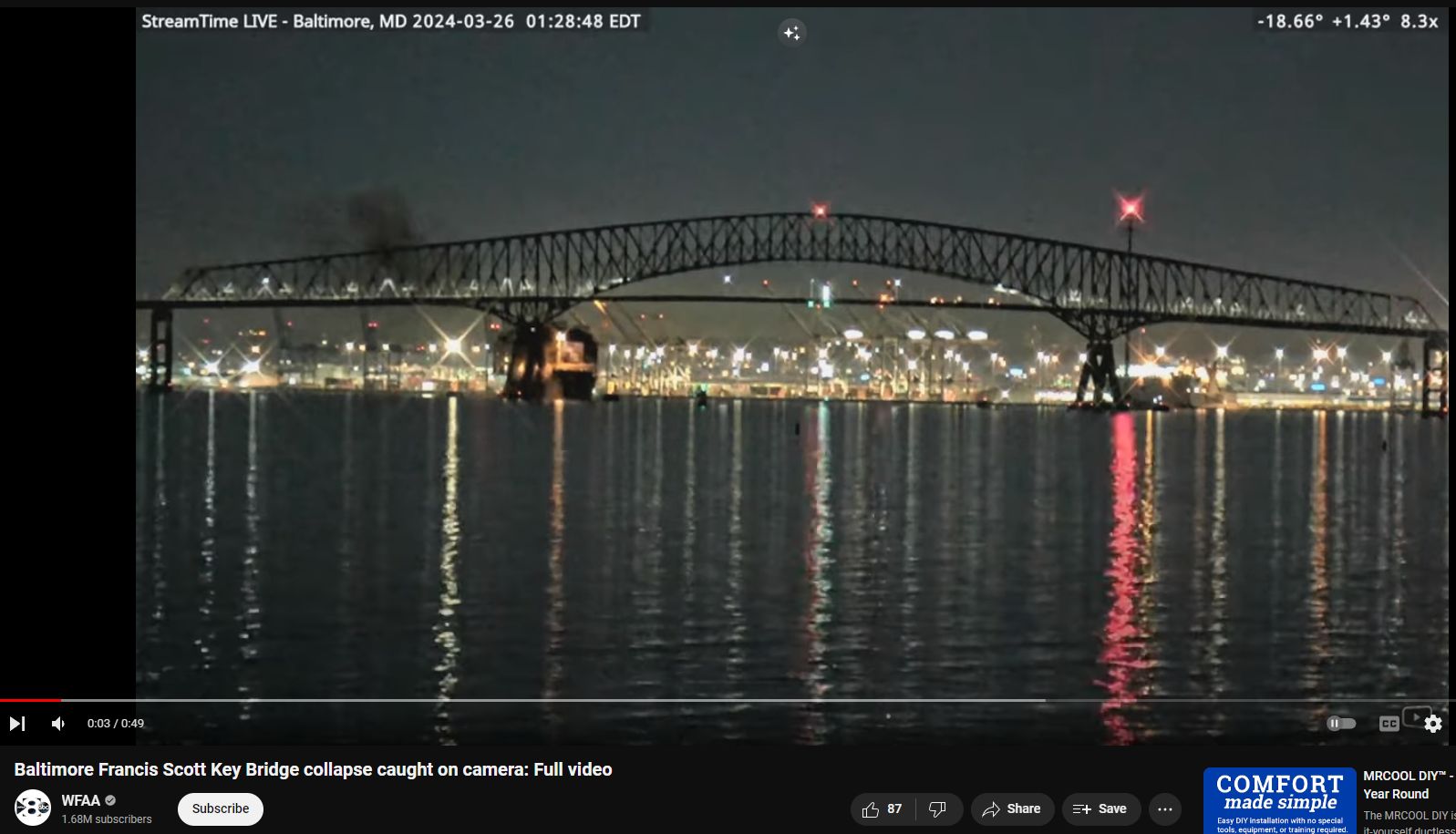“The Baltimore Francis Scott Key Bridge take-down was a trillion-dollar costly event, ongoing, and yet all culpable persons remain unnamed, kept totally anonymous, with some reportedly having been slyly ‘escaped’ from the country! There is, in fact, zero publicly-verifiable evidence that any genuine Captain, Pilots or Crew ever existed: Was DALI a remote-controlled ghost-ship on kamikazee mission from its outset? No waves or creaking metal nor splash-down sounds at all were recorded nor (initially) noted by any (reportedly) nearby persons; cameras recorded zero shaking, seismometers measured zero vibration. Anomalies and oddities galore overwhelm the aftermath, beguile reason, confound explanation. No interviews exist with supposed survivors; “family and friends” etc interviews reveal ‘dupers-delight’ micro-facial-expressions with other hallmarks suggestive of fraud. No verifications of any supposed deaths have yet been publicized. Rampant is the extremely suspicious damage with blatantly visible, verifiable anomalies (including massive, five-storys tall fireballs in both original night-time videos) totally inexplicable (and wholly ignored) by official theory or story. Grand payola galore is already underway with loads more coming. This event appears to involve another shabby yet audacious crime, militarized from gov to salvage to rebuild. There was no rescue skiff on scene as required by OSHA. No horn blasts from ship warned of imminent collision. The DALI ship departed despite (supposed) dire electrical problems, illegal at any time and even more highly unusual in the cold, dark night-time (part #94, first ‘after-sundown departure’ in two years). It goes on and on and on. Criminal was this manufactured event, through and through, and that’s before considering the absurd number of other anomalies ignored by the complicit, owned, ‘kept-pet’ mass-media…”
Part #91 adapted from a video comment.
Don’t miss the apparent precursor Tampa Bay Sunshine Skyway Bridge take-down test-run in 1981.
Index . Oddity List . Official Story . Summary
Verifiably severe mismatch of 3rd camera footage (“Zapruder 2.0 C-roll”) from MDTA / CNN
CNN Fake News ?
BELOW: MDTA traffic camera footage, provided by CNN, strangely (reportedly) cuts out just before impact (but before power outage due to allision).

Also strange: Supposed MDTA bridge traffic video provided by CNN (ABOVE) shows a presumed work-truck sitting at the north-end beginning of overhead trusswork. However, in the main night-time wide view of the bridge (BELOW), no such truck is seen at the north-end beginning of trusswork, and in fact the only visible four trucks are on the north side of the main span. This serious discrepancy plainly shows one or both of the videos is altered and/or false. My bet: it’s the CNN-provided video that’s Fake News.
 No work truck is seen at all at the far north (image-right) end of the overhead trusswork, where CNN/MDTA footage shows a worktruck in another video that seems altered ‘fake news’
No work truck is seen at all at the far north (image-right) end of the overhead trusswork, where CNN/MDTA footage shows a worktruck in another video that seems altered ‘fake news’
The “Zapruder 2.0 B-roll” video provided by “Toby Gutermuth” of two trespassers at Fort Armistead recording the event seems to match the main Zapruder 2.0 video. No flashing light of any work truck is visible at the far (distant) north-end of the overhead trusswork; however, a ‘white-hot burst’ is visible, presumably an attack point of the Directed Energy Weapons which seem to provide the obly plausible explanation for all evidence. https://www.youtube.com/shorts/9qBo9yD5LIk Aside from its shake-free perfect timing, perfect zooming and perfect framing, this video is highly suspicious also because it shows zero waves after the splash-down and also records zero impact sound, zero creaking steel sounds, and zero splash-down sounds, despite clearly recording audio. Also curious and perhaps criminal is zero presence of warning horn blasts from the ship! Sound conveys extremely well over water, especially at cool temperatures. That nothing audible is recorded except voices and some kind of atmospheric ‘room tone’ is remarkably suspicious.
The CNN-provided video is the mismatching anomaly. CNN. CFN. C (aught again spewing) Fake News.
Note that this is also a militarized operation. The military is known and expected liars. It is highly likely that the footage was faked before being fed to CNN; however, CNN should have verified the footage / image(s) against other known sources as part of routine job function in gathering and reporting news. Whether by lapdog parroting and/or laziness, CNN reveals itself again as unworthy of trust.
Unmasking Fake News: CNN’s Troubling Instances of Fabrication and Manipulation
Introduction
In an era where information flows freely and rapidly, the term “fake news” has become increasingly significant. It refers to the deliberate spread of misinformation, often intended to mislead or manipulate public perception. While fake news can be found across various media platforms, it is particularly alarming when established news organizations are implicated in such practices. CNN, one of the most prominent news networks globally, has faced several accusations and instances where it has been caught fabricating news, altering footage, or manipulating content for dramatic or editorial effect. This blog post delves into some of these notable cases, highlighting the importance of media integrity and the need for vigilant consumption of news.
The Phenomenon of Fake News
Fake news encompasses a range of deceptive practices, including:
1. Fabrication: Creating entirely false stories or events.
2. Manipulation: Altering footage or images to misrepresent reality.
3. Selective Reportin*: Omitting crucial information to skew the narrative.
4. Sensationalism: Exaggerating details to provoke emotional responses.
CNN’s Controversial Instances
1. The Gulf War Coverage
During the Gulf War in the early 1990s, CNN was accused of staging scenes to dramatize their coverage. Critics pointed to footage showing reporters appearing to be in a war zone, which was later suggested to have been filmed in a studio with fake backgrounds and sound effects. Although CNN has denied these allegations, the controversy sparked debates about the authenticity of war reporting.
2. Hurricane Harvey Rescue Footage
In 2017, during the coverage of Hurricane Harvey, CNN was criticized for allegedly staging a rescue scene. Footage showed a dramatic rescue of a man from a submerged truck, which some viewers claimed appeared rehearsed and orchestrated. CNN defended the footage, but the incident fueled skepticism about the network’s portrayal of real-time events.
3. The Russian Collusion Narrative
The extensive coverage of alleged collusion between the Trump campaign and Russia led to several retractions and corrections by CNN. Notably, three journalists resigned after a story linking a Trump associate to a Russian investment fund was found to be based on flawed sources. This incident underscored the dangers of prioritizing speed and sensationalism over rigorous fact-checking.
4. Editing the 2016 Milwaukee Protests Footage
In 2016, during the Milwaukee protests following a police shooting, CNN was accused of editing footage to change the context of a protester’s statement. The network aired a segment where a protester was shown saying, “Burn it down!” but the full footage revealed he had said, “We need our community! We need our businesses! We need our investments! And they are not here. And you all want to burn it down.” This selective editing was criticized for misrepresenting the protester’s message and inflaming tensions.
5. The Covington Catholic Incident
In 2019, CNN faced backlash for its coverage of an encounter between a group of Covington Catholic High School students and a Native American elder at the Lincoln Memorial. Initial reports portrayed the students as aggressors, based on a short video clip. However, additional footage revealed a more complex situation, leading to widespread criticism of CNN for jumping to conclusions and contributing to a misleading narrative.
The Implications of Fake News
The instances mentioned above highlight the broader implications of fake news:
– Erosion of Trust: Repeated instances of misinformation can erode public trust in media institutions.
– Polarization: Misleading news contributes to societal polarization by reinforcing biases and divisions.
– Impact on Individuals: Inaccurate reporting can have serious consequences for individuals, as seen in the Covington Catholic case.
Conclusion
Fake news is a pervasive issue that undermines the credibility of journalism and the informed citizenry it serves. While CNN is not alone in facing accusations of fabrication and manipulation, its high profile makes its actions particularly impactful. These instances underscore the importance of media literacy, critical consumption of news, and the need for accountability in journalism. As consumers of news, it is essential to question, verify, and seek multiple perspectives to navigate the complex landscape of information in the digital age.